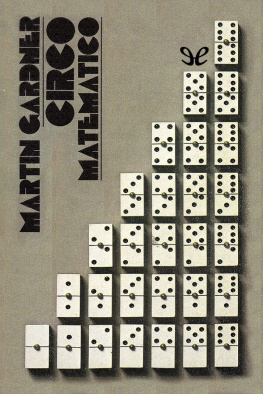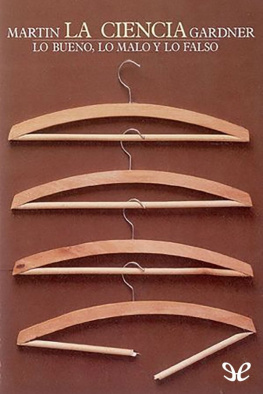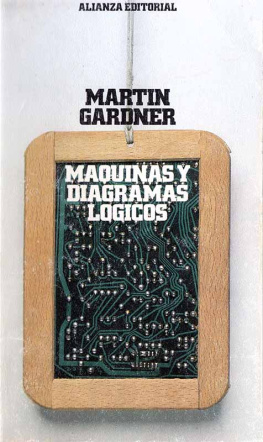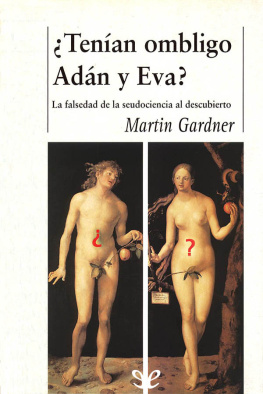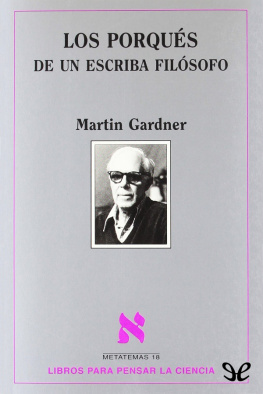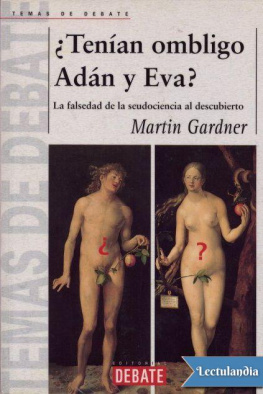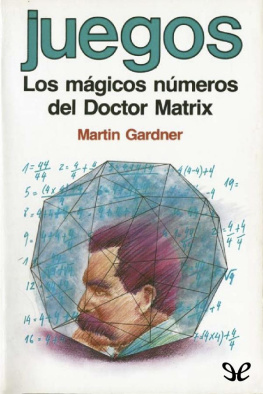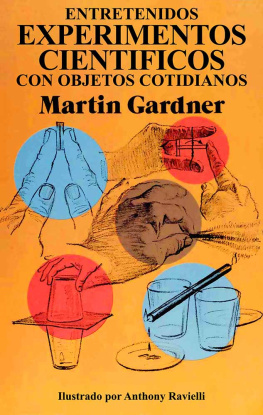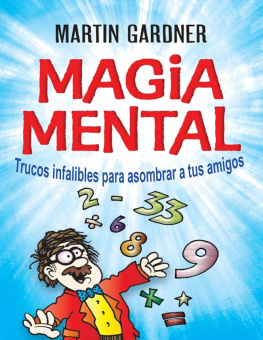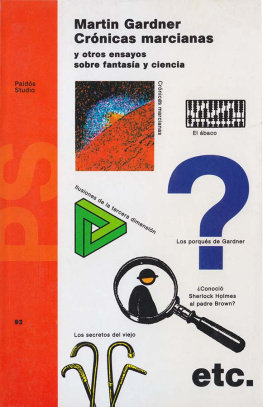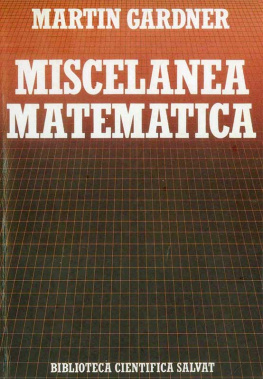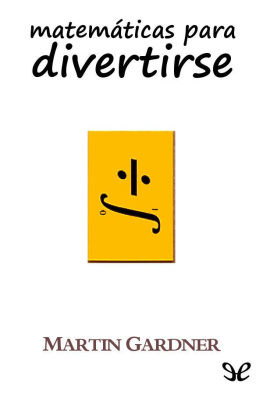Martin Gardner - Circo matemático
Aquí puedes leer online Martin Gardner - Circo matemático texto completo del libro (historia completa) en español de forma gratuita. Descargue pdf y epub, obtenga significado, portada y reseñas sobre este libro electrónico. Año: 1968, Editor: ePubLibre, Género: Historia. Descripción de la obra, (prefacio), así como las revisiones están disponibles. La mejor biblioteca de literatura LitFox.es creado para los amantes de la buena lectura y ofrece una amplia selección de géneros:
Novela romántica
Ciencia ficción
Aventura
Detective
Ciencia
Historia
Hogar y familia
Prosa
Arte
Política
Ordenador
No ficción
Religión
Negocios
Niños
Elija una categoría favorita y encuentre realmente lee libros que valgan la pena. Disfrute de la inmersión en el mundo de la imaginación, sienta las emociones de los personajes o aprenda algo nuevo para usted, haga un descubrimiento fascinante.
- Libro:Circo matemático
- Autor:
- Editor:ePubLibre
- Genre:
- Año:1968
- Índice:4 / 5
- Favoritos:Añadir a favoritos
- Tu marca:
- 80
- 1
- 2
- 3
- 4
- 5
Circo matemático: resumen, descripción y anotación
Ofrecemos leer una anotación, descripción, resumen o prefacio (depende de lo que el autor del libro "Circo matemático" escribió él mismo). Si no ha encontrado la información necesaria sobre el libro — escribe en los comentarios, intentaremos encontrarlo.
Circo matemático — leer online gratis el libro completo
A continuación se muestra el texto del libro, dividido por páginas. Sistema guardar el lugar de la última página leída, le permite leer cómodamente el libro" Circo matemático " online de forma gratuita, sin tener que buscar de nuevo cada vez donde lo dejaste. Poner un marcador, y puede ir a la página donde terminó de leer en cualquier momento.
Tamaño de fuente:
Intervalo:
Marcador:
1. Ilusiones ópticas
Optical Illusions. S. Tolansky. Macmillan, 1964.
Visual Illusions: Their Causes, Characteristics, and Applications. Matthew Luckiesh, with a new introduction by William H. Ittelson. Dover, 1965.
Eye and Brain. Richard L. Gregory. McGraw-Hill, 1966. [Trad. cast.: Ojo y cerebro, Guadarrama, Madrid, 1964].
The Intelligent Eye. Richard L. Gregory. McGraw-Hill, 1970.
«Impossible Objects as Nonsense Sentences.» D. A. Huffman en Machine Intelligence 6. Bernard Meltzer y Donald Michie (editors). Edinburgh University Press, 1971.
Illusion in Nature and Art. Richard L. Gregory y E. H. Gombrich. Scribner’s, 1973.
«The Theory of Braids and the Analysis of Impossible Figures.» Thaddeus M. Cowan, Journal of MathematicaI Psychology, Vol. 11, agosto 1974, págs. 190-212.
«Organizing the Properties of Impossible Figures.» Thaddeus M. Cowan, Perception, Vol. 6, 1977, págs. 41-56.
«Visual Illusions that Can Be Achieved by Putting a Dark Filter over One Eye.» Jearl Walker. Scientific American, marzo 1978, Amateur Science Deparment.
2. Cerillas
Match-Stick Magic. Will Blyth. C. Arthur Pearson, 1921.
Match-ic. Martin Gardner. Ireland Magic Company, 1935.
«Match Puzzles.» Henry Ernest Dudeney en 536 Puzzles and Curious Problems. Martin Gardner (editor). Scribner’s, 1967, págs. 201-8.
«Hit-and-Run on a Graph.» Jurg Nievergelt y Steve Chase, Journal of Recreational Mathematics, Vol. 1, abril 1968, págs. 112-17.
3. Esferas e hiperesferas
An Introduction to the Geometry of N Dimensions. D. M. Y. Sommerville. Methuen & Co. Ltd., 1919; Dover, 1958.
«The Problem of the Thirteen Spheres.» John Leech, Mathemetical Gazette, Vol. 40, febrero 1956, págs. 22-23.
«On a Theorem in Geometry.» Daniel Pedoe, American Mathematical Monthly, Vol. 74, junio 1967, págs. 627-40.
«Some Sphere Packings in Higher Space.» John Leech, Canadian Journal of Mathematics, Vol. 16, 1964, págs. 657-82.
«Notes on Sphere Packings.» John Leech, Canadian Journal of Mathernatics, Vol. 19, 1967, págs. 251-67.
«Five Dimensional Non-Lattice Sphere Packings.» John Leech, Canadian Mathematical Bulletin, Vol. 10, 1967, págs. 38793.
Twelve Geometrical Essays, Caps. 8, 9 y 12. H. S. M. Coxeter. Southern Illinois University Press, 1968.
«Six and Seven Dimensional Non-Lattice Shere Packings.» John Leech, Canadian Mathematical Bulletin, Vol. 12, 1969, págs. 151-55.
«The Kiss Precise.» W. S. Brown, American Mathematical Monthly, Vol. 76, junio 1969, págs. 661-63.
«New Sphere Packings in Dimensions 9-15.» John Leech y N. J. A. Sloane, Bulletin of the American Mathematical Society, Vol. 76, septiembre 1970, págs. 1006-10.
«Sphere Packings and Error-Correcting Codes.» John Leech y N. J. A. Sloarte, Canadian Journal of Mathematics, Vol. 23, 1971, págs. 718-45.
4. Pautas de inducción
A History of Board Games Other than Chess. H. J. R. Murray. Oxford University Press, 1952.
Games of the Orient. Stewart Culin. Charles Tuttle, 1958.
Board and Table Games from Many Civilizations. R. C. Bell. Oxford University Press, 1960.
Board and Table Games 2 from Many Civilizations. R. C. Bell. Oxford University Press, 1969.
A Gamut of Games. Sidney Sackson. Random House, 1969.
Games of the Worid. Frederic V. Grunfeld, editor. Holt, Rinehart and Winston, 1975.
5. Los elegantes triángulos
College Geometry: An Introduction to the Modern Geometry of the Triangle and the Circle. Nathan Altshiller Court. Barnes and Noble, 1952.
Geometry Revisited. H. S. M. Coxeter y Samuel L. Greitzer. Random House, 1967.
El problema del cuarto triángulo equitátero
Introduction to Geometry. H. S. M. Coxeter. Wiley, 1961, Sección 1.8.
Geometric Transfórmations. 1. M. Yaglom. Random House, 1962, págs. 93-94.
«The Triangle Reinvestigated.» J. Garfunkel, American Mathematical Monthly, Vol. 72, enero 1965, págs. 12-20.
El problema de las cevianas trisectrices
One Hundred Mathematical Curiosities. William R. Ransom. Walch, 1955, págs. 172-73.
Ingenious Mathematical Problems and Methods. L. A. Graham. Dover, 1959, Problema 52.
Introduction to Geometry. H. S. M. Coxeter. Wiley, 1961, sección 13.55.
Mathematical Snapshots. Hugo Steinhaus. Oxford University Press, 3.1 ed. rev., 1969, págs. 8-9.
«Trisection Triangle Problems.» Marjorie Bicknell, Mathematics Magazine, Vol. 69, febrero 1976, págs. 129-34.
Triángulos congruentes a 5
«More-than-similar Triangles.» C. Salkind, Mathematics Teacher, Vol. 47, diciembre 1954 -págs. 561-62.
«Problem E 1162.» Victor Thebault, American Mathematical Monthly, Vol. 62, 1955, págs. 255, 729-30.
Ingenious Mathematical Problems and Methods. L. A. Graham. Dover, 1959, Problema 59.
«Mystery Puzzler and Phi.» Marvin H. Holt, Fibonacci Quarterty, Vol. 3, abril 1965, págs. 135-38.
«5-Con Triangles». Richard G. Pawley, Mathematics Teacher,
Fibonacci and Lucas Numbers. Verner E. Hoggatt, Jr. Houghton Mifflin, 1969, Cap. 4.
«Almost Congruent Triangles.» Robert T. Jones y Bruce B. Peterson, Mathematics Magazine, Vol. 47, sept. 1974, págs. 180-89.
Fórmula de Herón
A Short Account of the History of Mathematics. W. W. Rouse Ball. Dover, 1960, Cap. 4.
«A Simpler Proof of Heron’s Formula.» Claude H. Raifaizen, Mathematics Magazine, Vol. 44, enero 1941, págs. 27-28.
Problema de las tres distancias
Ingenious Mathematical Problems and Methods. L. A. Graham. Dover, 1959, problema 55.
Mathematical Quickies. Charles W. Trigg. McGraw-Hill, 1967, problema 201.
El problema de las escaleras cruzadas
«Answer to Problem E 433.» Albert A. Bennett, American Mathematical Monthly, Vol. 48, abril 1941, págs. 268-69.
Ingenious Mathematical Problems and Methods. L. A. Graham. Dover, 1952, problema 25.
One Hundred Mathematical Curiosities. William R. Ransom. Walch, 1955, págs. 43-46.
Mathematical Puzzles, Geoffrey Mott-Smith. Dover, 1954, problema 103.
«The Crossed Ladders.» H. A. Arnold, Mathematics Magazine, Vol. 29, 1956, págs. 153-54.
«Complete Solution of the Ladder Problem in Integers.» Alan Sutcliffe, Mathematical Gazette, Vol. 47, mayo 1963, págs. 133-36.
«Answer to Problem 5323.» Gerald J. Janusz, American Mathematical Monthly, Vol. 73, diciembre 1966, págs. 112527.
The Surprise Attack in Mathematics. L. A. Graham. Dover, 1968, problema 6.
«The Ladder Problem.» William L. Schaaf en A Bibliography of Recreational Mathematics, Vol. 1. National Council of Teachers of Mathematics, 4.a edition, 1970, págs. 31-32.
6 y 7. Paseos aleatorios
«Random Paths in Two and Three Dimensions.» W. H. MeCrea y F. J. Whipple, Proceedíngs of the Royal Society of Edinburgh, Vol. 60, 1940, págs. 281-98.
An Introduction to Probability Theory and Its Applications. William Feller. Wiley, Vol. 1, 1957; Vol. 2, 1966.
«Finite Markov Chains.» John G. Kemeny, Hazleton Mirkil, J. Laurie Snell, y Gerald L. Thompson en Finite Mathematical Structures. Prentice-Hall, 1959.
Probability and Statisties. Frederick Mosteller, Robert E. K. Rourke, y George B. Thomas, Jr. Addison-Wesley, 1961.
Random Walks. E. B. Dynkin y V. A. Uspenskii. Heath, 1963.
«Random Walks.» John G. Kemeny en Enrichment in Mathematics for High School
Tamaño de fuente:
Intervalo:
Marcador:
Libros similares «Circo matemático»
Mira libros similares a Circo matemático. Hemos seleccionado literatura similar en nombre y significado con la esperanza de proporcionar lectores con más opciones para encontrar obras nuevas, interesantes y aún no leídas.
Discusión, reseñas del libro Circo matemático y solo las opiniones de los lectores. Deja tus comentarios, escribe lo que piensas sobre la obra, su significado o los personajes principales. Especifica exactamente lo que te gustó y lo que no te gustó, y por qué crees que sí.

